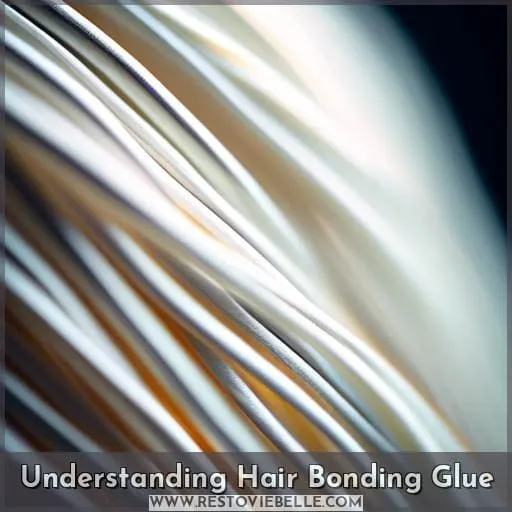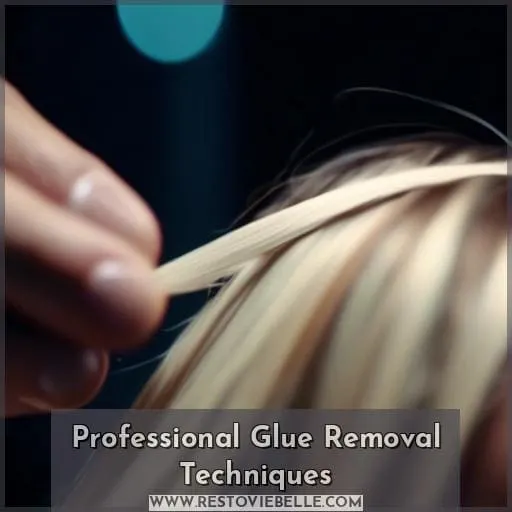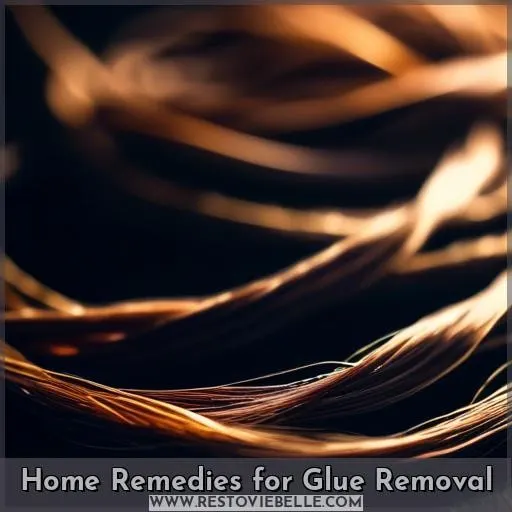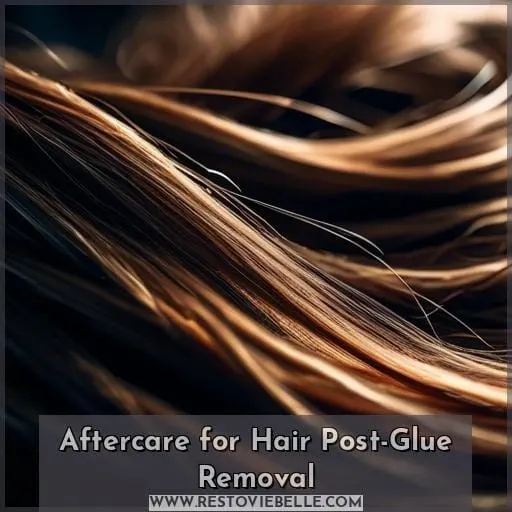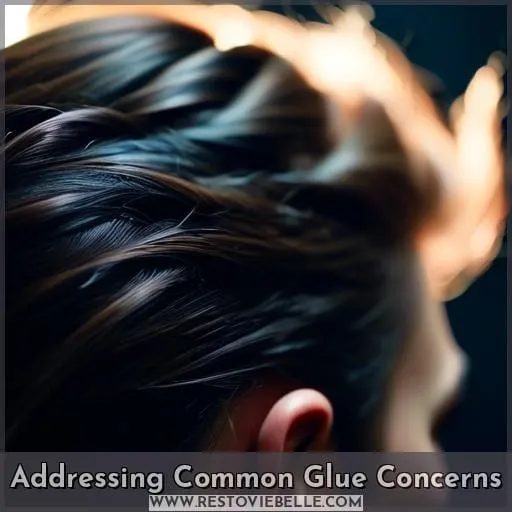This site is supported by our readers. We may earn a commission, at no cost to you, if you purchase through links.
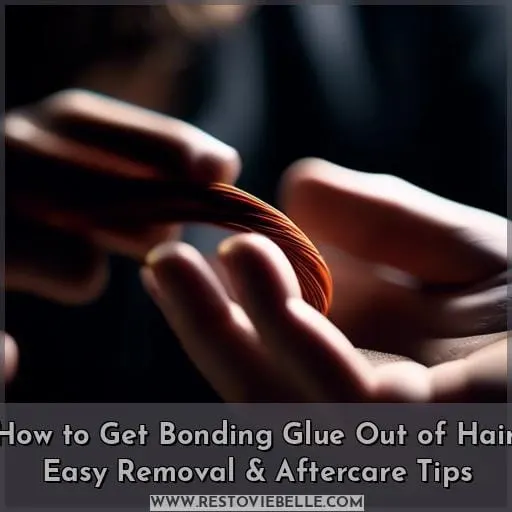 Removing bonding glue from your hair can feel like a daunting task, especially after a DIY hair extension project goes awry or when salon visits aren’t an option.
Removing bonding glue from your hair can feel like a daunting task, especially after a DIY hair extension project goes awry or when salon visits aren’t an option.
Whether you’re dealing with latex-based glues, keratin polymers, or acrylics for that long-lasting hold, there’s no need to panic. From professional techniques involving Liquid Gold and hot irons to home remedies like the peanut butter method or using dish soap, this guide covers safe and effective ways to free your locks from stubborn adhesive.
Plus, we’ll dive into essential aftercare to ensure your hair remains healthy and vibrant post-glue removal. Let’s tackle how to get bonding glue out of hair together, ensuring your mane stays as free and untangled as your spirit desires.
Yes, you can get bonding glue out of hair by using oil to break down the glue or a specialized hair bond remover for a safe and damage-free removal.
Table Of Contents
- Key Takeaways
- Understanding Hair Bonding Glue
- Professional Glue Removal Techniques
- Home Remedies for Glue Removal
- Aftercare for Hair Post-Glue Removal
- Addressing Common Glue Concerns
- Frequently Asked Questions (FAQs)
- Can hair bonding glue cause allergic reactions, and how can they be treated?
- What are the environmental impacts of disposing of hair bonding glue and removal products?
- How can I remove hair bonding glue from clothing or fabric?
- Are there any professional hair care treatments recommended after DIY glue removal to ensure hair health?
- What precautions should be taken when using hair bonding glue on colored or chemically treated hair to avoid damage?
- Conclusion
Key Takeaways
- Professional glue removal techniques such as Liquid Gold with a hot iron, Citrus C-22 solvent, and pure acetone are effective for dissolving and removing hair bonding glue.
- Home remedies like peanut butter, apple cider vinegar, dish soap, hair oil, and conditioner can be used to break down and remove glue from hair.
- After removing hair glue, it is important to deep condition the hair, trim split ends, and use a heat protectant to maintain hair health and prevent further damage.
- Common concerns when removing hair glue include the use of oil-based solutions like Vaseline and alcohol, which can dissolve the glue but require caution due to potential hair damage.
Understanding Hair Bonding Glue
When it comes to hair bonding glue, you have several options depending on your needs and preferences.
Latex-based glues offer a flexible hold and are ideal for temporary extensions. They transform into a rubbery texture as they dry.
If you’re looking for something that can withstand heat styling, keratin polymer options are your go-to.
For those seeking a long-term solution, acrylic glues are known for their solid material and strong hold.
Latex-Based Glues
Latex-based glues are a popular choice for hair bonding due to their strong adhesive strength and thick consistency. However, they can pose a risk of hair damage potential, especially if you’re sensitive to latex properties.
When dry, this glue becomes rubbery, making it a durable option for weaves and extensions.
If you’re looking for homemade alternatives to commercial hair glue remover, substances like oil or peanut butter can help remove bonding glue without harsh chemicals.
Always consider the health of your hair and scalp when choosing bonding methods and removal strategies.
Keratin Polymer Options
Keratin Polymer Options
Keratin polymer options for hair bonding glue are designed for those seeking a balance between durability and hair health. This type of glue softens under heat, allowing for easy application of hair extensions.
Once cooled, it solidifies, securing the extensions in place. The heat activation process ensures that the bond strength is sufficient to hold the extensions for an extended period without causing significant hair damage.
However, keratin bond removal requires specific techniques to avoid harming the natural hair. Products like hair oil, hair conditioner, and acetone can be used as bonding glue removers. These substances help in keratin glue softening, making the removal process less stressful on the hair.
It’s crucial to approach both the application and removal processes with care to maintain the integrity of the natural hair while enjoying the versatility of hair extensions.
Acrylic for Longevity
After exploring the versatility and effectiveness of keratin polymer options for hair bonding, it’s crucial to delve into the realm of acrylic for longevity. Acrylic-based glues stand out for their exceptional durability and bond strength, making them a preferred choice for long-term hair extension wear.
However, their robust adhesion also means they can be more challenging to remove.
- Acrylic Durability: Acrylic glues offer unparalleled longevity comparison, ensuring your hair extensions stay securely in place for extended periods.
- Bond Strength: The adhesion versatility of acrylic glues means they can bond strongly to various hair types, providing a reliable hold.
- Longevity Comparison: When compared to other types of hair bonding glues, acrylic stands out for its ability to maintain a solid bond for longer, reducing the need for frequent touch-ups.
- Removal Difficulty: Due to their strong bond, methods like peanut butter, apple cider vinegar, dish soap, nail polish remover, and specialized products may be necessary to effectively dissolve the acrylic glue without damaging the hair.
Understanding how to get bonding glue out of hair, especially acrylic-based, is essential for maintaining hair health and ensuring easy removal when it’s time to take out or replace your extensions.
Professional Glue Removal Techniques
When it comes to professional glue removal techniques for hair bonding glue, you have several options.
Liquid Gold and a hot iron can be used to effectively dissolve the bond, allowing for easier removal of hair extensions.
Citrus C-22 Solvent is another option, known for its fast-acting and skin-friendly properties, making it a popular choice for removing various adhesives.
For a more straightforward approach, pure acetone can be applied to break down the adhesive, although this method should be used with caution to avoid damaging the hair.
Liquid Gold and Hot Iron
When it comes to professional glue removal techniques, Liquid Gold and a hot iron can be a game-changer. Liquid Gold’s effectiveness lies in its ability to dissolve strong bonding glues without causing damage to your natural hair.
When paired with a hot iron, the heat helps to soften the bond, making it easier to remove the extensions. However, it’s crucial to prioritize hair safety during this process. Excessive heat can weaken hair strands and lead to breakage, so it’s important to use the hot iron judiciously and at a temperature that won’t cause further harm.
Always remember that maintaining the integrity of your hair is paramount, and while these methods are effective, they should be used with care to prevent any potential damage.
Citrus C-22 Solvent
Citrus C-22 solvent is a professional-grade adhesive remover that’s favored for its efficiency and safety. It’s particularly effective for dissolving the bond strength of hair glues without causing hair damage.
- Apply Citrus C-22 directly to the adhesive area.
- Allow it to sit for about a minute to soften the glue.
- Gently comb out the residue and follow with a shampoo wash.
This solvent is known for its quick action and is gentle on the skin, making it a go-to choice for removal safety. Its application methods are straightforward, ensuring you can remove hair extensions without undue stress to your hair.
Pure Acetone Application
When transitioning from using Citrus C-22 solvent to pure acetone for professional glue removal, it’s crucial to understand the potency and risks associated with acetone.
This chemical is highly effective at breaking down hair bonding glue due to its solvent properties. However, it’s essential to proceed with caution. Acetone can cause chemical damage if not used properly.
Before applying, conduct a patch test to ensure your scalp and hair can tolerate it. Always use acetone in a well-ventilated area to avoid inhaling fumes, and adhere to safety precautions like wearing gloves to protect your skin.
Home Remedies for Glue Removal
When it comes to removing bonding glue from your hair at home, there are several effective and accessible methods you can try.
Utilizing common household items like peanut butter, apple cider vinegar, dish soap, hair oil, and conditioner can offer simple solutions to this sticky problem.
These items work through various mechanisms, such as the oil content in peanut butter breaking down the glue, the acidity of apple cider vinegar weakening the glue’s bond, and the compounds in dish soap dissolving glue bonds, making them easier to wash out or comb through your hair.
Peanut Butter Method
After transitioning from professional techniques, let’s delve into the peanut butter method for glue removal.
Surprisingly, peanut butter’s oils can effectively break down the stubborn substances in hair glue. For application, generously coat the affected hair with peanut butter and gently massage it in. It’s crucial to let it sit under a shower cap for about 30 to 45 minutes to maximize its effectiveness.
Afterward, wash your hair thoroughly, using conditioner to aid in the removal process. While combing out any remaining glue, take precautions to avoid pulling too hard to prevent hair loss.
Apple Cider Vinegar Use
Apple cider vinegar (ACV) is a versatile household item that can also be an effective solution for removing hair bonding glue. Its acidity helps to break down the glue, making it easier to comb out of your strands.
- Apply a small amount of ACV to the glued areas of your hair.
- Gently massage the vinegar into the glue to help loosen its grip.
- Wait a few minutes for the ACV to work its magic on softening the glue.
- Comb through your hair gently to remove the glue residues.
When using ACV for glue removal, it’s important to consider the safety of your hair types and the potential odor. ACV is generally safe for most hair types, but its strong smell can be off-putting to some.
Rinsing thoroughly after use can help mitigate the odor. Always prioritize the health of your strands and scalp to maintain their integrity and appearance.
Dish Soap Solution
To effectively remove hair extensions at home, dish soap can be a powerful ally due to its grease-cutting strength. This common household item is a DIY removal option that can break down the adhesive bonds of hair glue, offering home remedy benefits for those seeking a cost-effective solution.
When using dish soap, it’s important to consider chemical safety concerns, as the goal is to remove hair extensions without damaging your hair or scalp. Apply the dish soap directly to the areas where the glue is present, let it sit to penetrate the bonds, and then rinse thoroughly.
Always follow up with a deep conditioning treatment to restore moisture to your hair.
Hair Oil Assistance
To effectively remove hair bonding glue from your hair, you can turn to various hair oil types and application techniques.
- Choose the right hair oil, considering alternative oil options like coconut, olive, or almond oil for their nourishing properties.
- Apply the oil directly to the areas with glue, using gentle massaging motions to ensure the oil penetrates and starts breaking down the adhesive.
- Allow the oil to sit and work its magic, giving it time to loosen the glue’s bond with your hair.
- Use a comb or your fingers to gently separate the glue from your hair, then follow up with a suitable oil removal method, such as shampooing.
Conditioner as Remover
After exploring various homemade solutions for removing hair bonding glue, let’s delve into the use of hair conditioner as an effective remover. Conditioner benefits your hair by not only aiding in glue removal but also providing hair damage prevention.
Unlike some oil-based alternatives, conditioners are typically chemical-free options that can help maintain the integrity of your hair.
Here’s a quick comparison of different methods:
| Method | Benefits | Considerations |
|---|---|---|
| Peanut Butter | Oil content breaks down glue | May be messy, requires thorough washing |
| Apple Cider Vinegar | Acidity weakens glue bonds | Can be harsh on sensitive scalps |
| Hair Conditioner | Moisturizes while removing glue | Gentle, prevents hair damage |
Conditioners are a go-to for many because they’re readily available and can be less harsh than other chemical removers. They’re part of the homemade solutions that can safely assist in the removal process while ensuring your hair remains healthy and free from harsh chemicals.
Aftercare for Hair Post-Glue Removal
After successfully removing bonding glue from your hair, it’s crucial to focus on aftercare to ensure your hair remains healthy and strong.
Start by treating your hair with a deep conditioner to replenish moisture and repair any damage caused by the glue.
Regular trims are also essential to remove split ends and prevent further breakage.
Lastly, always apply a heat protectant before using any styling tools to shield your hair from potential heat damage.
Deep Conditioning
After removing hair bonding glue, deep conditioning is crucial to restore health and moisture balance to your hair.
This process involves applying a rich, nourishing treatment that penetrates deep into the hair shaft, providing a significant moisture or protein boost.
Deep conditioning helps to prevent breakage by improving hair elasticity and restoring the natural shine that may have been dulled by chemical treatments or physical stress.
Regularly incorporating deep conditioning into your hair care routine can significantly enhance your hair’s overall health, making it stronger, more resilient, and less prone to damage.
It’s an essential step in ensuring your hair remains hydrated, vibrant, and healthy after the stress of glue removal.
Trimming Split Ends
After removing hair glue, focusing on split end treatment is crucial for hair health maintenance.
- Regular Trims: Schedule them to prevent further hair breakage.
- Damage Minimization: Cutting off damaged ends stops breakage from traveling up the hair shaft.
- Hair Health Maintenance: Keeping ends fresh aids in overall hair strength and appearance, ensuring your locks stay healthy and vibrant.
Heat Protectant Usage
After trimming split ends to prevent further damage, it’s crucial to shield your hair from heat damage during styling.
Heat protectants act as a barrier, safeguarding your hair from the high temperatures of styling tools. When applying a heat protectant, ensure even coverage by sectioning your hair and using the product as directed—whether it’s a spray, cream, or oil.
This step is essential in your hair care routine to maintain healthy hair, minimize frizz, and keep your style looking smooth and polished. Remember, proper product application can prevent limp hair and protect against the intense heat that can permanently alter your hair’s structure.
Addressing Common Glue Concerns
When it comes to addressing common concerns about removing bonding glue from hair, it’s essential to know that there are several effective methods.
Oil-based solutions, such as Vaseline and various hair oils, can break down the adhesive properties of the glue, making it easier to remove.
Additionally, using alcohol can weaken the glue bonds, allowing for easier removal without causing damage to your hair.
These methods provide safe and efficient ways to tackle the challenge of removing hair bonding glue, ensuring your hair remains healthy and free from residue.
Dissolving Glue Bonds
After you’ve taken steps to care for your hair post-glue removal, it’s important to understand how to dissolve glue bonds safely to prevent hair damage. The composition of the glue, application methods, and removal precautions all play a role in maintaining the integrity of your hair.
- Glue Composition: Be aware of the type of glue used, as some may require specific solvents for removal.
- Application Methods: Apply removal agents gently to avoid pulling and stressing the hair.
- DIY Removal Risks: Home remedies can be effective but carry the risk of hair damage if not done correctly.
Always prioritize hair damage prevention when choosing a method to dissolve glue bonds.
Oil-Based Solutions
When tackling hair glue, oil-based removers are your go-to. Olive oil not only dissolves the adhesive but also nourishes your locks. However, prepare for an oily aftermath, necessitating multiple washes. Weigh the cost against the quantity provided to ensure it’s a worthwhile investment.
| Solution | Benefits |
|---|---|
| Oil-based Removers | Dissolves glue effectively |
| Olive Oil | Nourishes hair |
| Multiple Washes | Removes oily residue |
Vaseline and Alcohol
Continuing from the discussion on oil-based solutions for glue removal, let’s delve into the effectiveness of Vaseline and alcohol.
- Vaseline application can be gentle on the skin and effective in breaking down the adhesive properties of hair glue.
- To use, apply a small amount of Vaseline to the glued areas and let it sit to weaken the bond.
- Alcohol strength is key when using it as a remover; a higher concentration can dissolve glue more quickly.
- Apply alcohol with a cotton ball, allow it to penetrate the glue, then gently comb out the residue.
Frequently Asked Questions (FAQs)
Can hair bonding glue cause allergic reactions, and how can they be treated?
Yes, hair bonding glue can cause allergic reactions, including anaphylaxis, due to high concentrations of latex antigen.
If you experience symptoms, seek medical attention; treatments may include antihistamines or topical steroids.
What are the environmental impacts of disposing of hair bonding glue and removal products?
Disposing of hair bonding glue and removal products can be likened to releasing a genie from a bottle—once out, the environmental impact is difficult to reverse.
These products often contain chemicals that, if not properly disposed of, can contribute to pollution and harm ecosystems.
How can I remove hair bonding glue from clothing or fabric?
To remove hair bonding glue from clothing, apply a few drops of acetone to the stain.
Are there any professional hair care treatments recommended after DIY glue removal to ensure hair health?
After a DIY glue removal, pamper your tresses with a professional deep conditioning treatment to quench their thirst.
Snip away any split ends to fend off breakage.
What precautions should be taken when using hair bonding glue on colored or chemically treated hair to avoid damage?
When using hair bonding glue on colored or chemically treated hair, it is important to avoid direct scalp application. Additionally, use minimal heat during the bonding process. Choose adhesives that are compatible with your specific hair type to prevent damage.
Conclusion
Despite any concerns you might have about removing bonding glue from your hair, rest assured that with the right approach, you can tackle this challenge effectively.
Whether you opt for professional techniques like Liquid Gold and hot irons or home remedies such as the peanut butter method or dish soap, you’ve got a variety of options to dissolve those stubborn glue bonds.
Remember to follow up with aftercare, like deep conditioning and trimming split ends, to keep your hair healthy. With patience and the right method, you’ll find how to get bonding glue out of hair is simpler than it seems, and you’ll be back to enjoying your free-flowing hair in no time.

